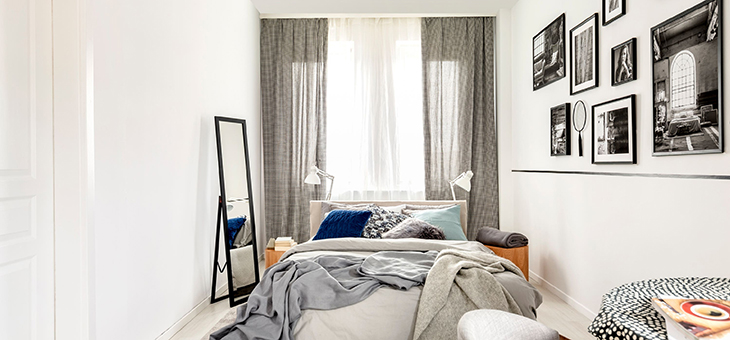For many of us, house space is a fiercely contested commodity, and you need to squeeze the most out of every square inch.
But luckily there are plenty of clever tricks you can use to make this happen. Mirrors, multi-functional furniture and a recurring colour or pattern are all your friends.
Here’s how to make even the smallest bedroom feel larger – without having to sleep on the sofa.
1. Let there be light
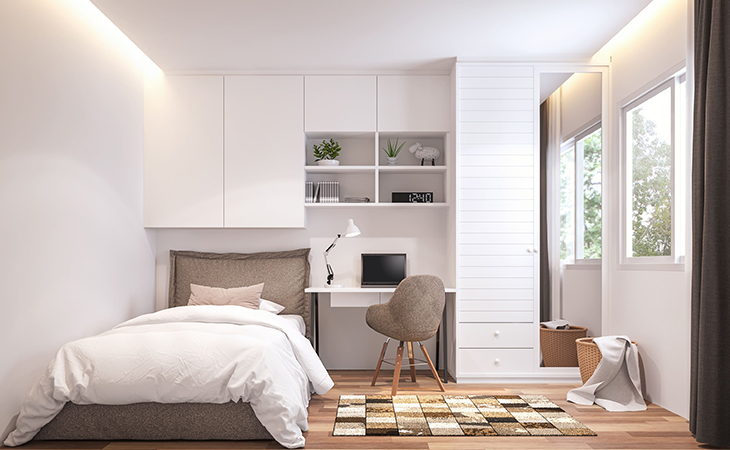
It’s the oldest rule in the book: bright, breezy spaces feel looser, larger and lighter, so put your bed on the opposite wall from your windows and keep them clear of clutter. Thick, heavy curtains will help you keep warm in winter, but they will also protrude physically and visually into your room, so dress your windows with unobtrusive blinds or rollers instead.
2. Under-bed storage is your friend
Every square inch counts when you’re space saving, and there should be no room for monsters beneath the bed once you’ve finished economising. Bags and boxes are good for long-term storage, but slide-out clothes drawers are especially expedient, as they lessen the need for that other great space-snatcher, a large wardrobe.
3. Make it a virtue
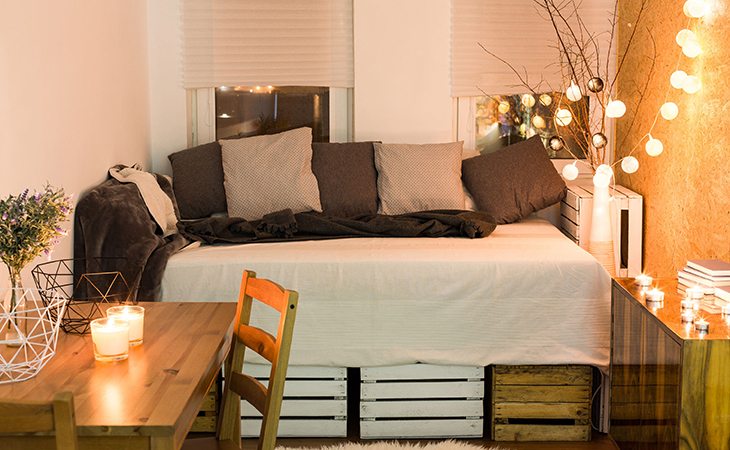
One person’s cramped is another person’s cosy, and a few soft furnishings can turn a poky shoebox into a snug den or bolthole. Think fuzzy blankets, chocolate box ornaments, warming lamps and lighting – anything you might associate with a comfy Scandinavian cabin on a cold winter’s day.
4. Mirror, mirror
Bedroom, entrance hall or downstairs loo – mirrors have long been number one on the list of domestic design tricks. They don’t add any physical space, of course, but they send light bouncing around the walls and can trick the eye into doubling a room’s depth.
For the best brightening effects, place your mirror opposite a window and for the greatest sense of space, consider the wall opposite the door.
5. Bed size matters
We know, it’s so tempting to snap up an XXL king size and spend every night splayed out like a starfish, but if floor space is precious, your bed is the obvious place to seek savings. If you’re 6’4″ and married, fair play; if you’re 5’3″ and single, perhaps consider downsizing.
6. Put your headboard to work
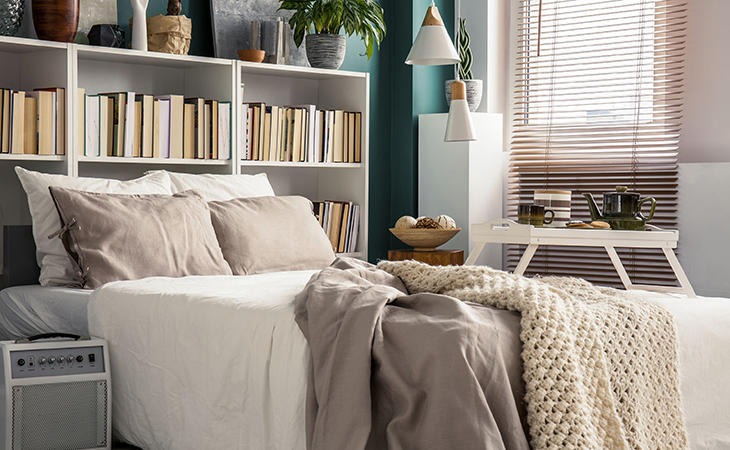
Select the right design and your headboard can double as shelves for storage; a tabletop for ornaments; a rail for hanging clothes – anything really besides a useless wooden plank.
7. Think vertically
Just as city centres maximise space by building upwards, so too can your bedroom. Think of a room in terms of volume, rather than surface area, and prioritise floor-to-ceiling units that can squeeze the most from every inch of your room. Add shelves atop wardrobes and cupboards, or just use them as storage space anyway.
If you are investing in mirrors, make them full-length, and design your room to draw the eye upwards. Consider vertically striped wallpaper, a different-coloured ceiling, and high-hung pictures and decor.
8. Choose furniture strategically
Pick pieces that can serve multiple purposes, or at least do the job as efficiently as possible. Double up your desk and bedside table; pick a compact cabinet over an elaborate chest of drawers; investigate foldaway futons.
9. Curate your colour scheme
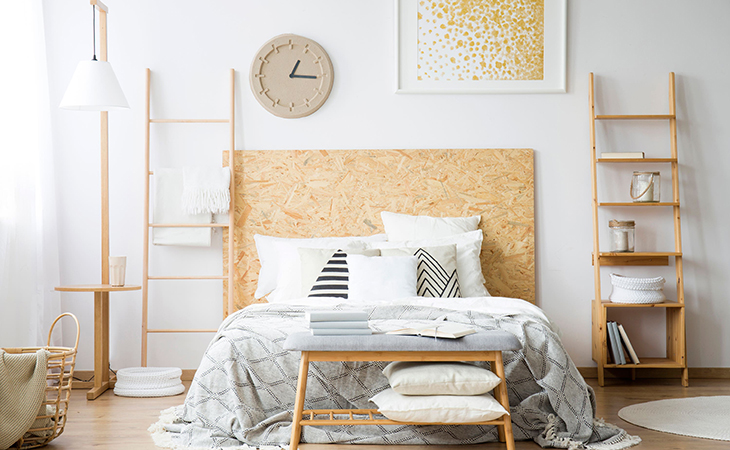
Lighter colours feel airier and more open, and there’s a reason that whites, greys and varying shades of cream crop up again and again in the centrefolds of interior design magazines. From your paint job to flooring and furnishings, avoid darker colours that might lend a claustrophobic feel.
10. Establish a theme
It doesn’t take much for small spaces to feel disorganised, and giving your room a designed, curated feel brings a much-needed sense of order. It could be a colour or pattern – recurring on cushions, bed covers and wallpaper – or a simple motif.
11. Declutter
Minimalism is as fashionable as it is functional, and most bedrooms bear at least a few bulky burdens that would be better off in an op shop. Do you really need that brick-sized Nokia with the first version of Snake, the box of expired medicines, or the tabletop popcorn maker you used once in 2015?
12. Marshal your corners
Corners are notoriously difficult to bring to heel, but unless you live in a lighthouse every room has at least three of them, and they can easily turn into dead space. Consider anything with a right angle – tables, light fixtures, or wraparound, triangular shelving.
13. Employ a feature wall
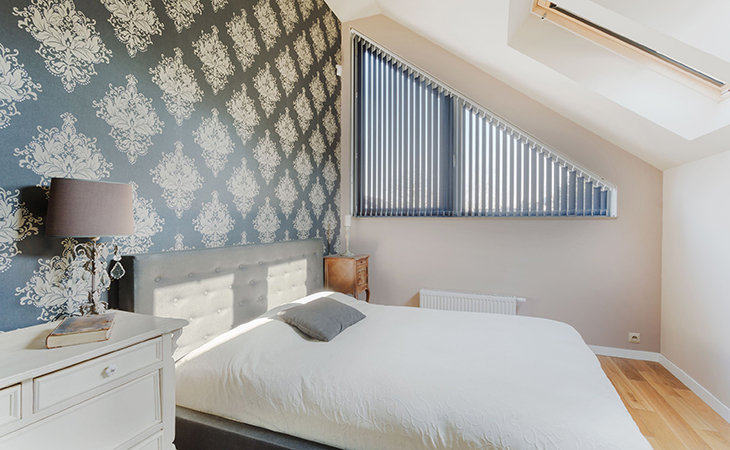
Every room benefits from a statement centrepiece, and in a shoe-box bedroom it can hardly be the four-poster bed. Physical focal points may struggle to squeeze in, so instead opt for a visual one – a well-decorated wall with an artwork, a photo collage, or simply a bold pattern.
Would you rather have a small bedroom or a small kitchen? Do you have any more space-enhancing tips for others living with a small bedroom?
– With PA
If you enjoy our content, don’t keep it to yourself. Share our free eNews with your friends and encourage them to sign up.
Related articles:
https://www.yourlifechoices.com.au/lifestyle/stylewatch/how-to-create-more-harmony-in-your-home
https://www.yourlifechoices.com.au/finance/tips-for-lifting-the-value-of-your-home
https://www.yourlifechoices.com.au/uncategorized/brighten-up-your-bathroom-on-a-budget

